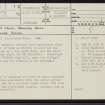Islay, Cnoc Na Croiche
Cross (Medieval), Cross Base (Early Medieval), Grave Slab (Medieval)
Site Name Islay, Cnoc Na Croiche
Classification Cross (Medieval), Cross Base (Early Medieval), Grave Slab (Medieval)
Alternative Name(s) Islay House Estate; Islay House Policies
Canmore ID 37746
Site Number NR36SW 1
NGR NR 33538 62510
Datum OSGB36 - NGR
Permalink http://canmore.org.uk/site/37746
- Council Argyll And Bute
- Parish Killarow And Kilmeny
- Former Region Strathclyde
- Former District Argyll And Bute
- Former County Argyll
NR36SW 1.00 33535 62511
NR36SW 1.01 cancelled site (see NR36SW 14.07)
(NR 33535 62511) Sculptured Stone (NR)
OS 6" map, Argyllshire (Islay), 2nd ed., (1900)
The late Mr Campbell erected this sculptured stone on the summit of Cnoc na Croich; he also had the summit enclosed by a low earth bank, and the small octagonal tower built (NR36SW 1.01 at NR 3351 6246). (Doubtless this was the "little flat hill, near the village" where Pennant saw the remains of the gallows.)
This monument is composed of parts of three separate sculptured slabs presumably from the burial ground (NR36SW 5) set on a circular basal cairn. The base of the shaft has scrollwork panels, figures, and an illegible inscription. It is probably 14th century. The top of the shaft has been hacked from a later sword slab. The flat slab which forms the top of the plinth is panelled but apart from a bird in one corner, the decoration is indecipherable.
Name Book 1878; T Pennent 1774; R C Graham 1895; W D Lamont 1972.
The cross-slabs, as described, stand to 3.2m high including the stone plinth, 1.0m across by 1.0m high.
Visited by OS (J M) 29 March 1979.
Field Visit (October 1980)
The following monuments formerly in the graveyard at Kilarrow see NR36SW 5, have been re-erected on the summit of Cnoc na Croiche, 30m N of the East Tower (nos.17-19). The others, 1-18 and 20-40 are in the burial-ground.
MEDIEVAL
(17) Part of a graveslab which in the 19th century was trimmed to shape and used to extend the cross-shaft number 18. It bears remains of interlace, followed by a sword resembling that on number 3 (see NR36SW 5) and flanked by a plant-scroll which issues from the tail of an animal above the right quillon. (Graham, 1895).14th-15th century.
(18) Lower part of a cross-shaft, augmented by the graveslab number 17 and standing in what was probably the original socket-stone. Despite various traditions that the cross was brought from another site, both the shaft and the base were described by Pennant in 1772 as being in the burial ground at Kilarrow. (Pennant 1772; The officers of the Ordnance Survey were told in 1878 that the cross was set up by Mr {Walter Fredrick} Campbell of Islay ' and brought from an old burying ground between Bridgend and Mulindry', presumably that at Ballitarsin {RCAHMS 1984}. The statement of J G MacNeill that it was brought by Campbell from Clachan an Tachair {Clachantachtree, NR 308 578} has been wrongly interpreted as referring to Hugh Morrison {Lamont 1968}. The shaft, which tapers perceptibly measures 1.37m in height, 0.33m in width at the foot, and 0.10m in thickness. The angles are wrought with double mouldings and the edges are undecorated. On one face, in descending order, there is a niche containing a kneeling woman with a rosary, and then attenuated foliaceous ornament, followed by a panel bearing an illegible inscription and a second niche containing the figure of horseman and some further letters of the inscription, the Lombardic capitals, of which only PAT/RIC(II] ('of Patrick) can be made out. The inscription continued on a further panel above a third niche, now almost completely effaced which appears to have contained a man wearing a bascinet The other face displays foliaceous ornament ending in a pair of beasts, and at the foot a much-worn panel of interlace.(Pennant, 1772; Graham, 1895). 14th-15th century.
(19) Socket-stone in which the cross-shaft number 18 stands. Raised on a modern pedestal, it measures 0.85m by 0.80m by 60mm in thickness and has been divided into panels by double-beaded mouldings. It is much worn, but it is possible that the corner panels contained the symbols of the evangelists since in one of them there is a bird, probably the eagle of St John. (Graham, 1895). 14th-15th century.
Visited October 1980
RCAHMS 1984
Measured Survey (1982 - 1983)
RCAHMS prepared measured drawings of the medieval cross (10), cross-shaft (18) and socket-stone (19) at Killarow in 1982/3. The drawings were published at a scale of 1:15 (RCAHMS 1984, figs. 186A and 187B)






















